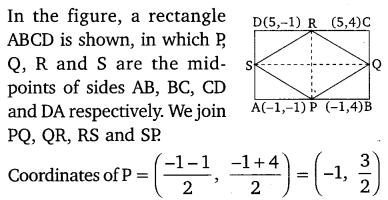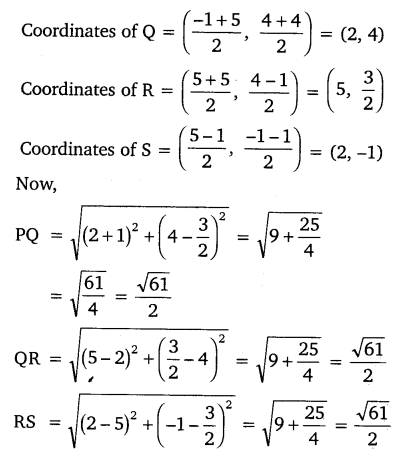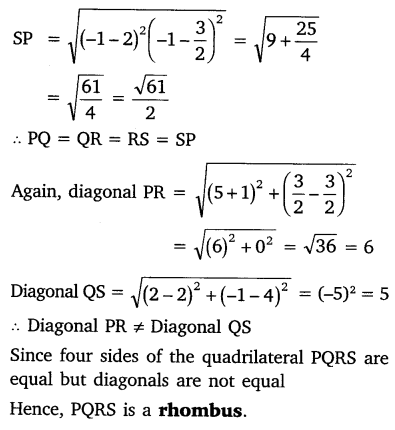Question 1.
Find the distance between the following pairs of points:
- (i) (2, 3), (4, 1)
- (ii) (-5, 7), (-1, 3)
- (iii) (a, b), (-a, -b)
Solution:
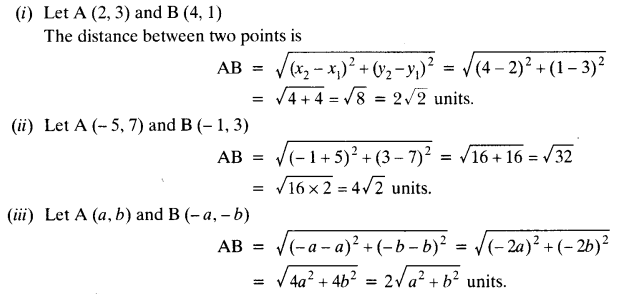
Question 2.
Find the distance between the points (0, 0) and (36, 15).
Solution:
Let points be A (0, 0) and B (36, 15)
The distance between two points is

Question 3.
Determine if the points (1, 5), (2, 3) and (-2, -11) are collinear.
Solution:
Let points be A (1, 5), B (2, 3) and C (-2, -11)

AB + BC ≠ AC
Hence, the given points are not collinear.
Question 4.
Check whether (5, -2), (6, 4) and (7, -2) are the vertices of an isosceles triangle.
Solution:
Let points be A(5, -2), B (6, 4) and C (7, -2)

Here, AB = BC
ΔABC is an isosceles triangle.
Question 5.
In a classroom, 4 friends are seated at the points A, B, C and D as shown in given figure. Champa and Chameli walk into the class and after observing for a few minutes Champa asks Chameli, “Don’t you think ABCD is a square?” Chameli disagrees. Using distance formula, find which of them is correct.
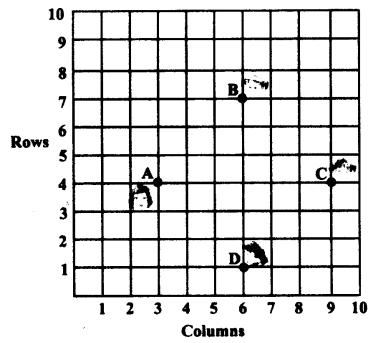
Solution:
Points A (3, 4), B (6, 7), C (9, 4) and D (6, 1)
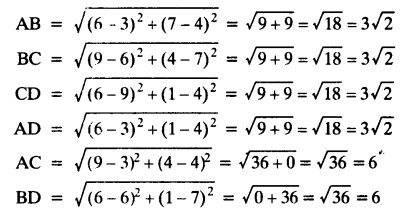
Here, AB = BC = CD = DA and AC = BD
ABCD is a square.
Hence, Champa is correct.
Question 6.
Name the type of quadrilateral formed, if any, by the following points, and give reasons for your answer.
- (i) (-1, -2), (1, 0), (-1, 2), (-3, 0)
- (ii) (-3, 5), (3, 1), (0, 3), (-1, -4)
- (iii) (4, 5), (7, 6), (4, 3), (1, 2)
Solution:
(i) Let points be A (-1, -2), B (1, 0), C (-1, 2) and D (-3, 0)
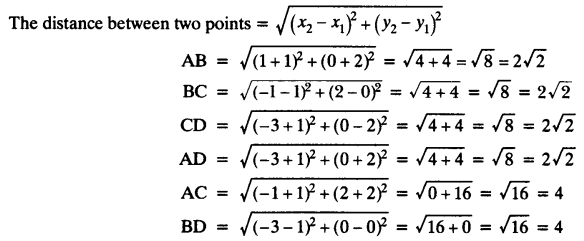
Here, AC = BD, AB = BC = CD = AD
Hence, the quadrilateral ABCD is a square.
(ii) Let points be A (-3, 5), B (3, 1), C (0, 3) and D (-1, -4)

The given points do not form any quadrilateral.
(iii) Let points be A(4, 5), B (7, 6), C (4, 3) and D (1, 2)
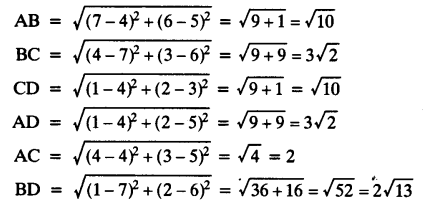
Here, AB = CD, BC = AD
and AC ≠ BD
The quadrilateral ABCD is a parallelogram.
Question 7.
Find the point on the x-axis which is equidistant from (2, -5) and (-2, 9).
Solution:
Let points be A (2, -5) and B (-2, 9)
Let P (x, 0) be the point on x-axis.
AP = BP

Question 8.
Find the values of y for which the distance between the points P (2, -3) and Q (10, y) is 10 units.
Solution:
Points P (2, -3), Q (10, y) and PQ = 10 units
The distance between two points is

Question 9.
If Q (0, 1) is equidistant from P (5, -3), and R (x, 6), find the values of x. Also find the distances QR and PR.
Solution:
Points are P (5, -3) and R (x, 6)
Point Q (0, 1) is equidistant from points P (5, -3) and R (x, 6).
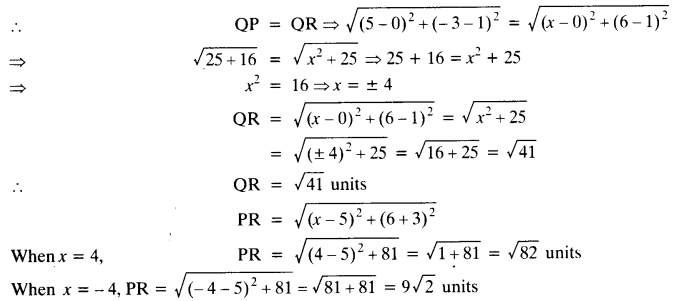
Question 10.
Find a relation between x and y such that the point (x, y) is equidistant from the points (3, 6) and (-3, 4).
Solution:
Points A(3, 6) and B(-3, 4) are equidistant from point P(x, y)


Chapter 7 Coordinate Geometry Ex 7.2
Question 1.
Find the coordinates of the point which divides the join of (-1, 7) and (4, -3) in the ratio 2 : 3.
Solution:

Question 2.
Find the coordinates of the points of trisection of the line segment joining (4, -1) and (-2, -3).
Solution:
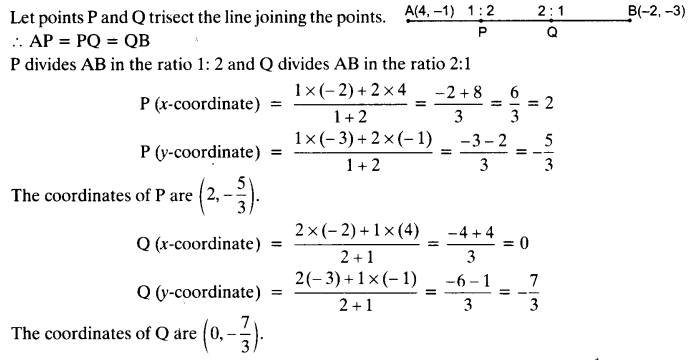
Question 3.
To conduct Sports Day activities, in your rectangular shaped school ground ABCD, lines have been drawn with chalk powder at a distance of 1 m each. 100 flower pots have been placed at a distance of 1 m from each other along AD, as shown in given
figure below. Niharika runs 1/4 th the distance AD on the 2nd line and posts a green flag. Preet runs 1/5 th distance AD on the eighth line and posts a red flag. What is the distance between both the flags? If Rashmi has to post a blue flag exactly halfway between the line segment joining the two flags, where should she post her flag?
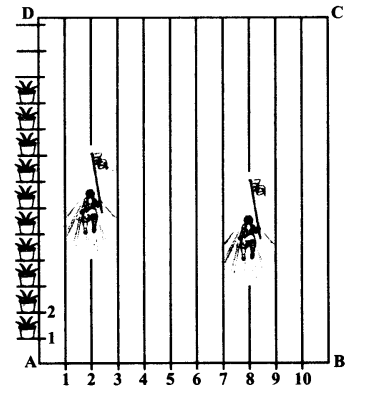
Solution:
y-coordinate of green flag = 1/4 x 100 m = 25 m
Coordinates of green flag are P (2, 25)
y-coordinate of red flag = 1/5 x 100 = 20
Coordinates of red flag are Q (8, 20)
The distance between two points is

The blue flag is in the 5th line, at a distance of 22.5 m.
Question 4.
Find the ratio in which the line segment joining the points (-3, 10) and (6, -8) is divided by (-1, 6).
Solution:
Let the required ratio be k : 1
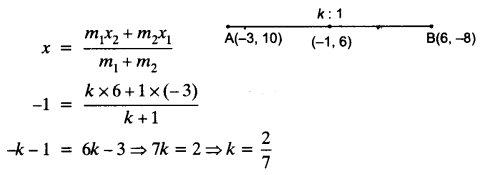

Question 5.
Find the ratio in which line segment joining A (1, -5) and B (-4, 5) is divided by the x-axis. Also, find the coordinates of the point of division.
Solution:
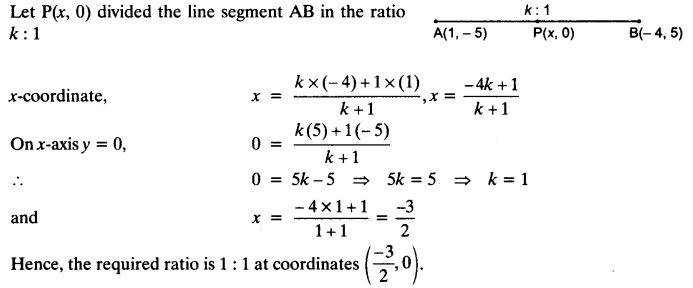
Question 6.
If (1, 2), (4, y), (x, 6) and (3, 5) are the vertices of a parallelogram taken in order, find x and y.
Solution:

Question 7.
Find the coordinates of a point A, where AB is the diameter of a circle whose centre is (2, -3) and B is (1, 4).
Solution:

Question 8.
If A and B are (-2, -2) and (2, -4), respectively, find the coordinates of P such that AP = 3/7 AB and P lies on the line segment AB.
Solution:
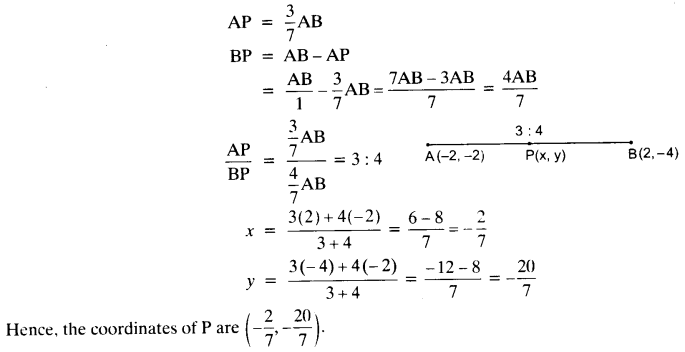
Question 9.
Find the coordinates of the points which divide the line segment joining A (-2, 2) and B (2, 8) into four equal parts.
Solution:

Question 10.
Find the area of a rhombus if its vertices are (3, 0), (4, 5), (-1, 4) and (-2, -1) taken in order.
[Hint: Area of a rhombus = 1/2 (product of its diagonals)]
Solution:
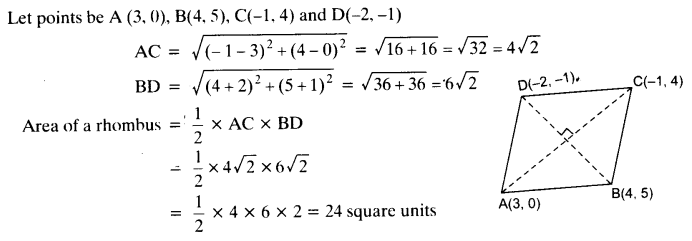
Chapter 7 Coordinate Geometry Ex 7.3
Question 1.
Find the area of the triangle whose vertices are:
- (i) (2, 3), (-1, 0), (2, -4)
- (ii) (-5, -1), (3, -5), (5, 2)
Solution:
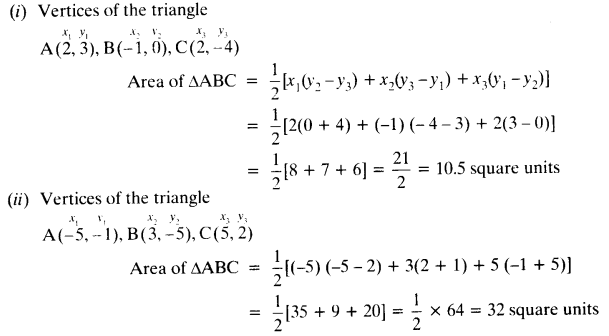
Question 2.
In each of the following find the value of ‘k’ for which the points are collinear.
- (i) (7, -2), (5, 1), (3, k)
- (ii) (8, 1), (k, -4), (2, -5)
Solution:
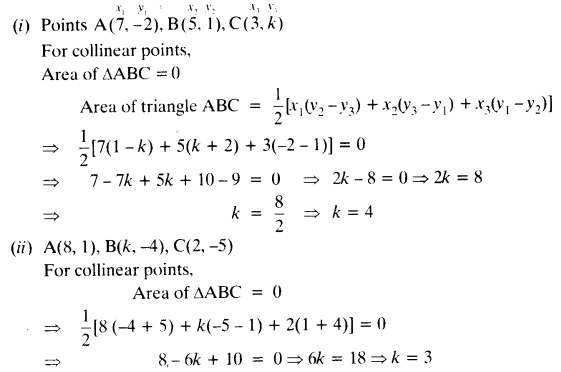
Question 3.
Find the area of the triangle formed by joining the mid-points of the sides of the triangle whose vertices are (0, -1), (2, 1) and (0, 3). Find the ratio of this area to the area of the given triangle.
Solution:
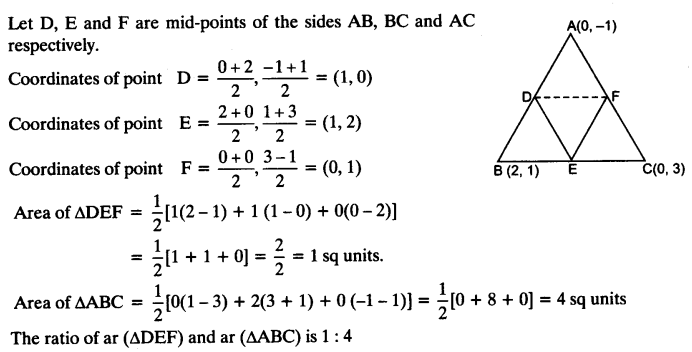
Question 4.
Find the area of the quadrilateral whose vertices, taken in order, are (-4, -2), (-3, -5), (3, -2) and (2, 3).
Solution:
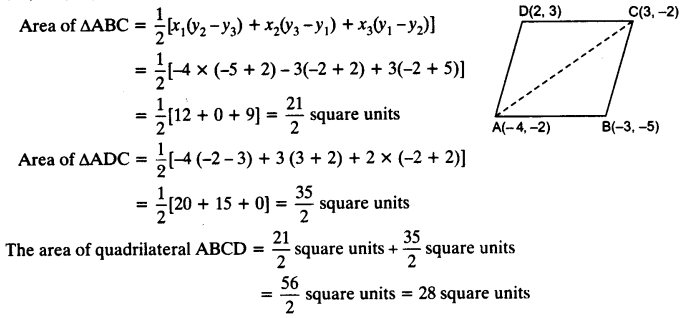
Question 5.
You have studied in Class IX, that a median of a triangle divides it into two triangles of equal areas. Verify this result for ∆ABC whose vertices are A (4, -6), B (3, -2) and C (5, 2).
Solution:


Chapter 7 Coordinate Geometry Ex 7.4
Question 1.
Determine the ratio, in which the line 2x + y – 4 = 0 divides the line segment joining the points A(2, -2) and B(3, 7).
Solution:
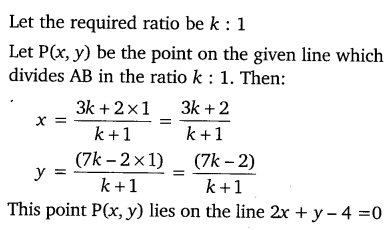
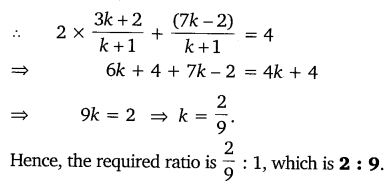
Question 2.
Find a relation between x and y, if the points (x, y), (1, 2) and (7, 0) are collinear.
Solution:
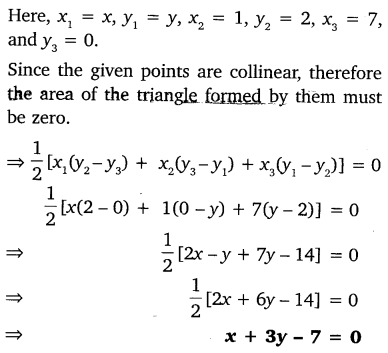
Question 3.
Find the centre of a circle passing through the points (6, -6), (3, -7) and (3, 3).
Solution:
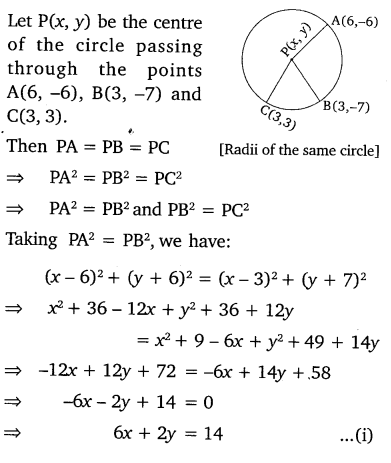
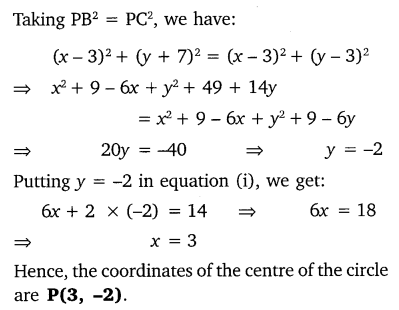
Question 4.
The two opposite vertices of a square are (-1, 2) and (3, 2). Find the coordinates of the other two vertices.
Solution:
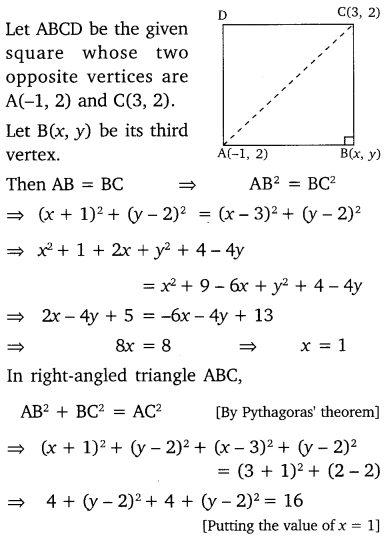

Question 5.
The class X students school in krishnagar have been alloted a rectangular plot of land for their gardening activity. Saplings of Gulmohar are planted on the boundary at a distance of 1 m fron eaach other. There is trianguler grassy lawn in the plot as shoen in the figure. The students are to sow seeds of flowering plants on the remaining area of the plot.
- (i) Taking A as origin, find the coordinates of the vertices of the triangle.
- (ii) What will be the coordinates of the vertices of ?PQR, if C is the origin?
Also, calculate the areas of the triangles in these cases. What do you observe?
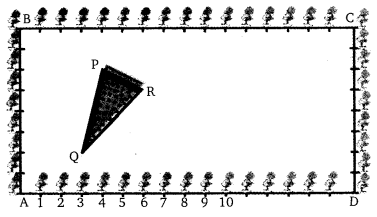
Solution


Question 6.
The vertices of a VABC are A(4, 6), B(1, 5) and C(7, 2). A line is drawn to intersect sides AB and AC at D and E respectively. such that AD/AB=AE/AC=14. calculate the area of the ∆ADe and compare it with the area of ∆ABC.
Solution:
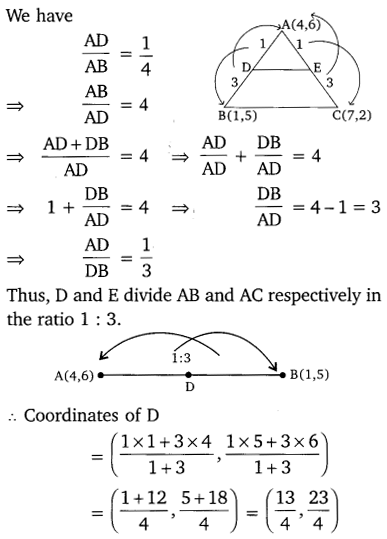

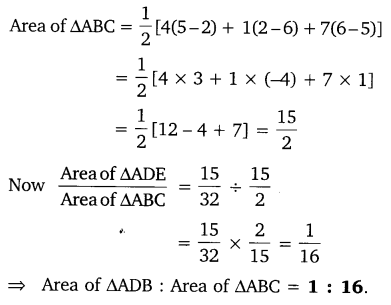
Question 7.
Let A(4, 2), B(6,5) and C(1, 4) be the vertices of ?ABC.
- (i)The median from A meters BC at D. Find the coordinates ofthe point D.
- (ii)Find the coordinates of the point P on AD, such that AP : PD = 2 : 1.
- (iii)Find the coordinates of points Q and R on medians BE and CF respectively, such that BQ : QE = 2 : 1 and CR : RF = 2 : 1.
- (iv)What do you observe?
- [Note:The points which is common to all the three medians is called centroid and this point divides each median in the ratio 2 : 1]
- (v)If A(x1, y1), B(x2, y2) and C(x3, y3) are the vertices of ∆ABC, find the coordinates of the centroid of the triangles.
Solution:
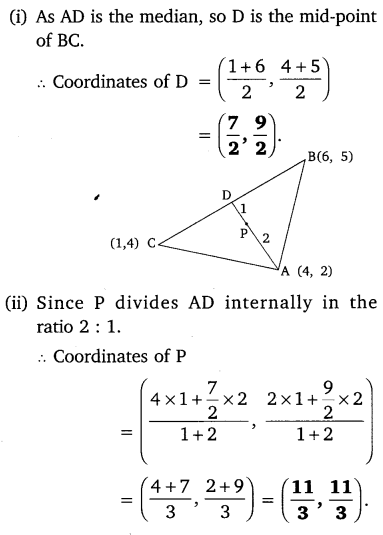
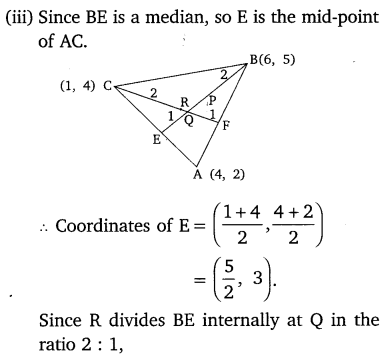
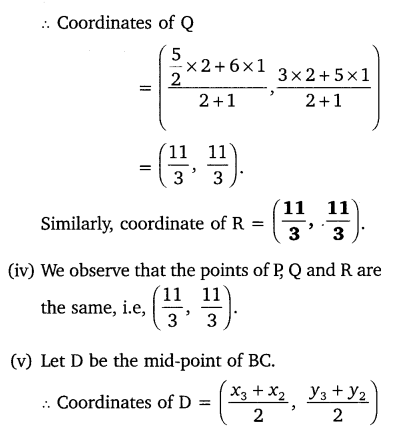
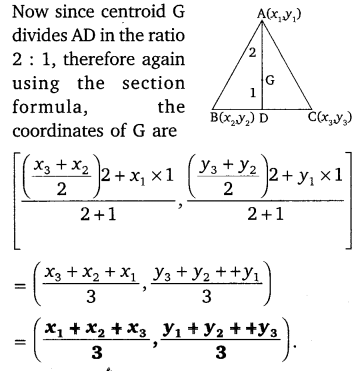
Question 8.
ABCD is a rectangle formed by the points A(-1, -1), B(-1, 4), C(5, 4) and D(5, -1), P, Q, R and S are the mid-points of Ab, BC, CD and DA respectively. Is the quadrilateral PQRS a square? a rectangle? or a rhombus? Justify your answer.
Solution:
